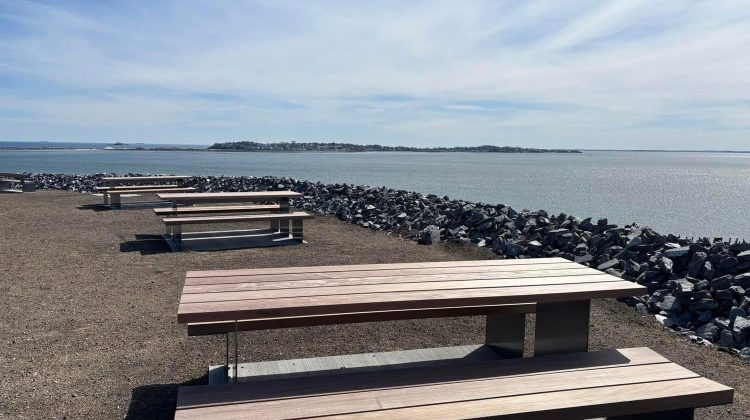LYNN — After years of planning, permitting, and environmental remediation, Lynn’s long-awaited Harbor Park is finally taking shape. A former landfill site along the Lynnway is being transformed into a 30-acre public park featuring scenic walking paths, picnic tables, gazebos, and sweeping views of the city’s long-inaccessible harborfront.
The project — nearly seven years in the making — is now in the final stages of Phase 1, with city officials anticipating a ribbon-cutting this June. The effort has been led by Charter Development in partnership with the City of Lynn, with landscaping and site preparation carried out by Leahy Landscaping.
“It’s coming along really nice,” said Ward Six Councilor Fred Hogan, who represents the area. “There are benches, picnic tables, a gazebo, and an unbelievable walking path. It’s going to be a gem for the city.”
More than 500 trees have already been planted across the site, which sits atop a fully capped former landfill. New staircases and wide gravel paths now lead through the space, offering public access to views of Lynn Harbor that had been blocked off for decades.
“The opening of Harbor Park this summer will be the culmination of a multi-year public-private partnership with Charter, EOEEA, MassDevelopment, EDIC, LWSC, A.W. Perry, city staff, the City Council, and the state delegation,” said Mayor Jared C. Nicholson.
“While work remains toward the overall vision for this space, we are thrilled at the beautiful access our residents will have to the waterfront, as well as what this project means for the neighborhood’s transformation into an opportunity for inclusive growth.”
Charter Development acquired over 30 acres of waterfront property for the project, including a 16-acre parcel transferred from National Grid. The site encompasses the former landfill and additional shoreline parcels. Extensive remediation work has included importing more than 540,000 cubic yards of grading material, repairing the landfill cap, and implementing coastal resiliency measures to safeguard the site from future flooding and storm surges.
The project aims to reclaim a stretch of industrial waterfront that had long been fenced off and underutilized. By converting it into public parkland, city leaders hope to improve residents’ quality of life and lay the groundwork for broader investment as part of Lynn’s 245-acre waterfront redevelopment vision.
“For too long, our residents have been cut off from the waterfront,” said City Council President Jay Walsh, who has supported the project from the beginning. “This is about restoring access and making the harbor something everyone can enjoy.”
Walsh drew early inspiration from Boston’s Spectacle Island — a former landfill that was similarly capped and turned into a thriving public park. Facing early skepticism around Lynn’s project, he took an unusual approach: personally ferrying fellow councilors by boat to Spectacle to help them see the potential.
“It’s hard to explain what it could be until you see it,” he said. “Once they saw Spectacle, they understood.”
Both Walsh and Hogan recalled their initial frustration when Charter first acquired the land, which had appeared as open space in conceptual planning documents. But that concern shifted after they met Charter President Robert Delholme, whose long-term vision for public access impressed them.
According to Walsh, Charter was originally only tasked with capping the landfill, but Delholme pushed for a broader vision that would benefit the community. “He said to us, ‘If I have to cut the grass here for the next 30 years, then this project wasn’t successful.’ He wanted to make this a place people could use — not just remediate and forget.”
Walsh said that the key to the park’s transformation was the involvement of landscape architects Brown, Richardson & Rowe — the same firm behind the design of Spectacle Island and Lynn’s rail trail. “They’ve been a huge partner,” he said. “If we didn’t have the right people in place, it just wouldn’t have happened.”
The park is expected to open in phases, beginning with a formal ribbon-cutting this spring. Amenities already in place include expansive walking trails, a hilltop gazebo, and what Walsh described as “breathtaking views.”
Other features in progress include a basketball court, two pickleball courts, and an outdoor performance space known as an Odeon — a stone amphitheater area designed for small public performances and gatherings.
“That idea actually came from former Mayor Judy Flanagan Kennedy,” Walsh noted. “She always wanted a small spot on the waterfront where people could perform. We kept that idea alive — and now there’s a space where someone can strum a guitar or put on a show, and people can sit and take it in.”
The overall vision for the project was developed during the tenure of Mayor Thomas M. McGee, with Harbor Park as the centerpiece of the city’s 2019 Waterfront Open Space Master Plan. The details were negotiated among the partner agencies under Mayor Nicholson.

